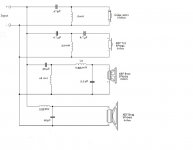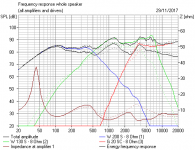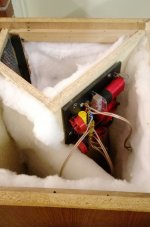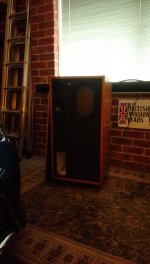I have just emailed Zaphod regarding the FN10
I’d tend to give Zaphod’s experience over Steve’s speculation.
dave
I’d tend to give Zaphod’s experience over Steve’s speculation.
dave
I'm going to build these xo, rewire them & fit new wool internally. I am using the latest - greatest components which are much better than 40 years ago. I will come back with my reviews on the new xo.
It was the IMF TLS80, driven by a Marantz 70wpc receiver I heard, as new. I didn't like them at all. Too smooth. Too bassy.
I am working desperately to keep on-topic here. What I did here was make an educated guess.
The Radford idea, and BTW, the resistors on the mid and tweeter input are select to taste.
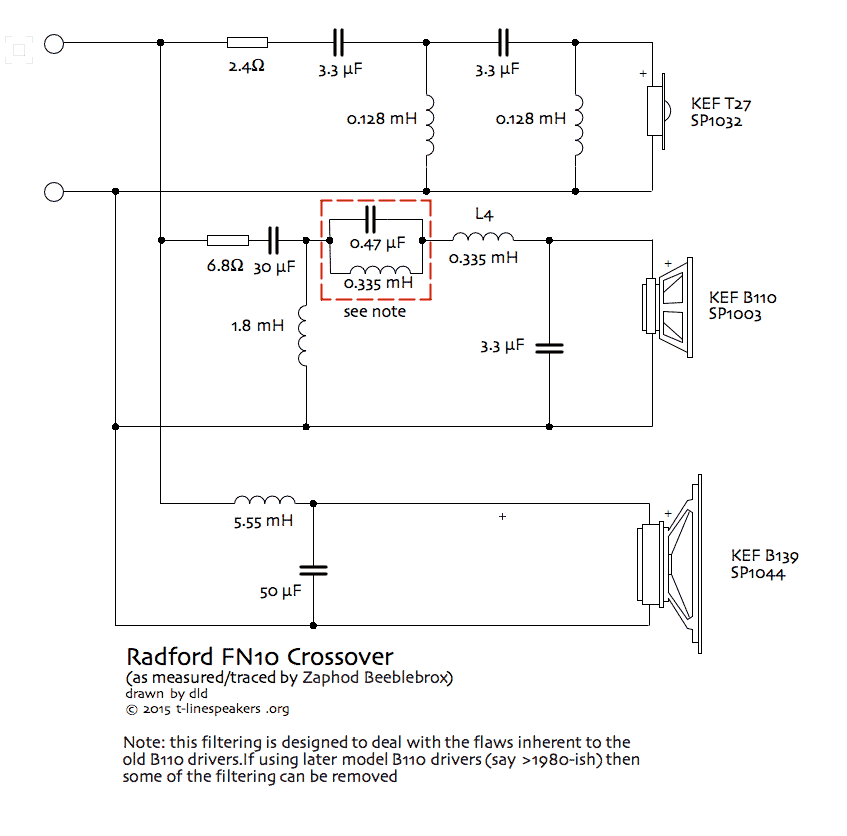
This is KEF's version:
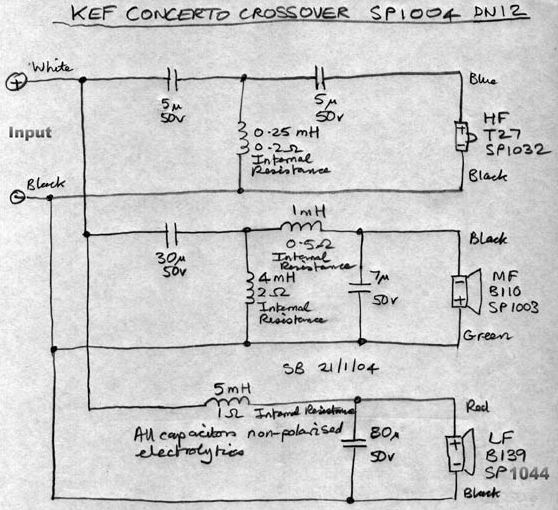
And this is my version:
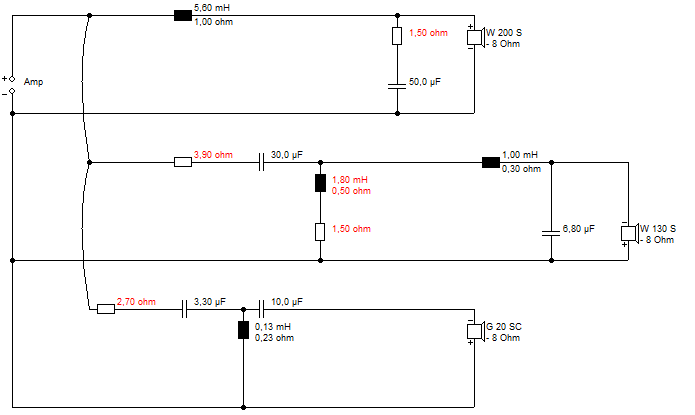
If you go to Falcon acoustics, or Wilmslow audio, you will find a number of improved crossovers for the KEF combination of B139, B110 and T27. One of the things KEF did in later Concerto's was change the 2mH shunt on the mid to 4mH, to get the 1kHz impedance up in the era of new transistor amps, which were replacing valves at this time. Another way to fix this is to add a small resistor to the near 2mH coil.
The classic 3.3uF/0.2mH/10uF type tweeter filter has a much better impedance than the Radford 4th order, which is clumsily implemented IMO. I don't mind 4th order, but DO IT RIGHT!
The Radford design crosses at 4.5kHz. The KEF at 3.5kHz. Who knows which is better. A matter of taste. But that 12kHz notch with 0.47uF across 0.33mH is plain daft and unnecessary. What's it supposed to do? 😀
In summary. The KEF design is competent. My design is competent and in the LR2 camp rather than BW3, and FWIW, I tried to reuse a lot of your components. The Radford design is a bit weird and especially poor on impedance. IMO. 😎
I am working desperately to keep on-topic here. What I did here was make an educated guess.
The Radford idea, and BTW, the resistors on the mid and tweeter input are select to taste.

This is KEF's version:
And this is my version:
If you go to Falcon acoustics, or Wilmslow audio, you will find a number of improved crossovers for the KEF combination of B139, B110 and T27. One of the things KEF did in later Concerto's was change the 2mH shunt on the mid to 4mH, to get the 1kHz impedance up in the era of new transistor amps, which were replacing valves at this time. Another way to fix this is to add a small resistor to the near 2mH coil.
The classic 3.3uF/0.2mH/10uF type tweeter filter has a much better impedance than the Radford 4th order, which is clumsily implemented IMO. I don't mind 4th order, but DO IT RIGHT!
The Radford design crosses at 4.5kHz. The KEF at 3.5kHz. Who knows which is better. A matter of taste. But that 12kHz notch with 0.47uF across 0.33mH is plain daft and unnecessary. What's it supposed to do? 😀
In summary. The KEF design is competent. My design is competent and in the LR2 camp rather than BW3, and FWIW, I tried to reuse a lot of your components. The Radford design is a bit weird and especially poor on impedance. IMO. 😎
Last edited:
Steve, do you want to recheck your design because I'm up for a challenge.
I will build the Radford for one speaker and since I have most of the parts to do your design I'll build it for the other. I will take pictures of both xo, put them on this forum then i will compare. If yours sounds better, I will put a badge stating xo was designed by you. So you up for the challenge?
Buy the way, can an acoustic butterworth be incorporated into the T27 for a nicer top end?
I will build the Radford for one speaker and since I have most of the parts to do your design I'll build it for the other. I will take pictures of both xo, put them on this forum then i will compare. If yours sounds better, I will put a badge stating xo was designed by you. So you up for the challenge?
Buy the way, can an acoustic butterworth be incorporated into the T27 for a nicer top end?
By the way Steve, Thankyou for trying to help me get the best out of these classic UK made speakers.
It was the IMF TLS80, driven by a Marantz 70wpc receiver I heard, as new. I didn't like them at all. Too smooth. Too bassy.
I am working desperately to keep on-topic here. What I did here was make an educated guess.
The Radford idea, and BTW, the resistors on the mid and tweeter input are select to taste.

This is KEF's version:

And this is my version:

If you go to Falcon acoustics, or Wilmslow audio, you will find a number of improved crossovers for the KEF combination of B139, B110 and T27. One of the things KEF did in later Concerto's was change the 2mH shunt on the mid to 4mH, to get the 1kHz impedance up in the era of new transistor amps, which were replacing valves at this time. Another way to fix this is to add a small resistor to the near 2mH coil.
The classic 3.3uF/0.2mH/10uF type tweeter filter has a much better impedance than the Radford 4th order, which is clumsily implemented IMO. I don't mind 4th order, but DO IT RIGHT!
The Radford design crosses at 4.5kHz. The KEF at 3.5kHz. Who knows which is better. A matter of taste. But that 12kHz notch with 0.47uF across 0.33mH is plain daft and unnecessary. What's it supposed to do? 😀
In summary. The KEF design is competent. My design is competent and in the LR2 camp rather than BW3, and FWIW, I tried to reuse a lot of your components. The Radford design is a bit weird and especially poor on impedance. IMO. 😎
Steve,
I'll quickly put together your recommended xo if you don't mind and give it a test to hear what it sounds like? What type of caps where, 50uF & the 30uF use electrolytic and the rest use polyprop?
It was the IMF TLS80, driven by a Marantz 70wpc receiver I heard, as new. I didn't like them at all. Too smooth. Too bassy.
I am working desperately to keep on-topic here. What I did here was make an educated guess.
The Radford idea, and BTW, the resistors on the mid and tweeter input are select to taste.

This is KEF's version:

And this is my version:

If you go to Falcon acoustics, or Wilmslow audio, you will find a number of improved crossovers for the KEF combination of B139, B110 and T27. One of the things KEF did in later Concerto's was change the 2mH shunt on the mid to 4mH, to get the 1kHz impedance up in the era of new transistor amps, which were replacing valves at this time. Another way to fix this is to add a small resistor to the near 2mH coil.
The classic 3.3uF/0.2mH/10uF type tweeter filter has a much better impedance than the Radford 4th order, which is clumsily implemented IMO. I don't mind 4th order, but DO IT RIGHT!
The Radford design crosses at 4.5kHz. The KEF at 3.5kHz. Who knows which is better. A matter of taste. But that 12kHz notch with 0.47uF across 0.33mH is plain daft and unnecessary. What's it supposed to do? 😀
In summary. The KEF design is competent. My design is competent and in the LR2 camp rather than BW3, and FWIW, I tried to reuse a lot of your components. The Radford design is a bit weird and especially poor on impedance. IMO. 😎
Steve,
I have made both the Radford & your xo, both sound terrible!!! B110 & T27 sound recessed and the T27 lacks detail. The Kef design is competent up until you give it some juice then it becomes distorted / harsh and unlistenable.
I have tested the below design and it sounds fantastic. I've added a Coles 4001 super tweeter for a more airy top end. The mid may need a few adjustments.
Attachments
Fantastic, chevolism! You've been working hard. 🙂
At least I did no worse than Radford... TERRIBLE! 😱
TBH, I think it's the levels on the mid and tweeter (red input resistors) which needed adjustment there. I'd always regard those as select on test.

Your current design is a bit iffy on low impedance, IMO.
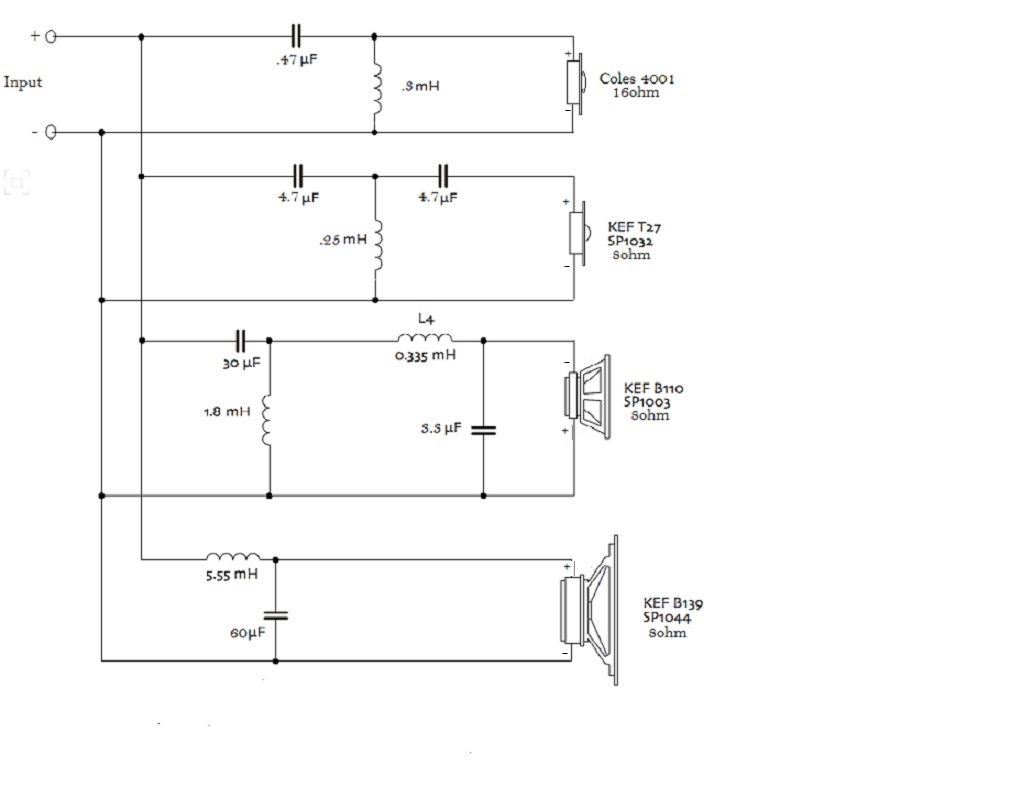
It's the KEF T27 Concerto filter and pretty much the bass filter too:

The mid is just a question of curve fitting in the Steen Duelund tradition.
Big question mark over tweeter polarity here. I'm scratching my head on that. You usually use positive polarity crossing a 5" to a 1". NPE capacitors can help a lot with some of the horrors too, because they have some (1R?) resistance built in.
I did a sim of where you are currently at on impedance. Disregard the driver responses. I am interested in what it's doing electrically. I love my amps, and try not to break them. Onwards and upwards. 😎
At least I did no worse than Radford... TERRIBLE! 😱
TBH, I think it's the levels on the mid and tweeter (red input resistors) which needed adjustment there. I'd always regard those as select on test.
Your current design is a bit iffy on low impedance, IMO.
It's the KEF T27 Concerto filter and pretty much the bass filter too:
The mid is just a question of curve fitting in the Steen Duelund tradition.
Big question mark over tweeter polarity here. I'm scratching my head on that. You usually use positive polarity crossing a 5" to a 1". NPE capacitors can help a lot with some of the horrors too, because they have some (1R?) resistance built in.
I did a sim of where you are currently at on impedance. Disregard the driver responses. I am interested in what it's doing electrically. I love my amps, and try not to break them. Onwards and upwards. 😎
Attachments
I have just finished installing the xo's into my dads Bailey's. I am speechless. I have made four versions of xo's and yesterday I just fitted my final version xo to one of the Bailey's and thought I would compare it to the DN12. My version blew it away. I was surprised at how bad the DN12 sounded, a very dull xo. My xo the sound coming through the T27 is really nice, cymbals sounded like they were right there, bright loud etc. All the little tinkles sounded sharp something the DN12 couldn't even produce. 60uF, 30uF have to be NP electrolytic but the rest you must use polypropylene caps. All aircore inductors. Drop those attenuators too. The super tweeter is not really needed but I'll add it to give the top end more air.
The whole neighborhood must of herd those Bailey's yesterday.
The whole neighborhood must of herd those Bailey's yesterday.
The XO attached in Post #48?
dave
Yes but with a few more improvements. They probably need a bit more of an improvement but do they sound good. I was amazed at how easily this crossover was driving the Kef's. I was driving them on a 55wrms amp and the volume @ 10 o'clock, they were loud but an even balance right through the spectrum with no distortion, very clear. The amp was just warm which is a good sign. I find that my IMF super compacts at the same level makes the amp run a little warmer.
Very happy with the outcome.
Last edited:
Once you have it nailed, please post it. With your permission i will clean it up and post it up on the TLS site.
dave
dave
Good evening,
I have built this speaker as well (KEF transmission line project - Page 7 - DIY Audio Projects - StereoNET) using the proposed Radford FN10 crossover. At the moment I haven't filled the TL cabinet with sheeps wool because it is a tedious procedure and I'm short on time. I was thinking of using another, easier material as I understand that sheep's wool has no magic properties when used over a TL, it's rather a density issue (right?). I have connected though the units to the crossover and... well it sounds terrible. I will not comment on the low end as I have not stuffed the box yet but the mid-high department sounds dull and pushed back. The best thing to do is to redesign a crossover for this setup, that takes into account any flaws of the units, either due to age or other factors.
I have measured the impedance of the speakers with the crossover as well as the impedance of each unit separately mounted on the box. B139 and B110 look rather good but the T27's have a wide spread and a second spike after the Fs. Has anyone tested any T27 before to comment on these curves? The diaphragms are new (old stock of course) and I'm worried for the presence of either oxidation in the gap or wrong diaphragm installation. I 'd appreciate any help.
Thank you in advance
View attachment t27_left.pdf
View attachment t27_right.pdf
I have built this speaker as well (KEF transmission line project - Page 7 - DIY Audio Projects - StereoNET) using the proposed Radford FN10 crossover. At the moment I haven't filled the TL cabinet with sheeps wool because it is a tedious procedure and I'm short on time. I was thinking of using another, easier material as I understand that sheep's wool has no magic properties when used over a TL, it's rather a density issue (right?). I have connected though the units to the crossover and... well it sounds terrible. I will not comment on the low end as I have not stuffed the box yet but the mid-high department sounds dull and pushed back. The best thing to do is to redesign a crossover for this setup, that takes into account any flaws of the units, either due to age or other factors.
I have measured the impedance of the speakers with the crossover as well as the impedance of each unit separately mounted on the box. B139 and B110 look rather good but the T27's have a wide spread and a second spike after the Fs. Has anyone tested any T27 before to comment on these curves? The diaphragms are new (old stock of course) and I'm worried for the presence of either oxidation in the gap or wrong diaphragm installation. I 'd appreciate any help.
Thank you in advance
View attachment t27_left.pdf
View attachment t27_right.pdf
Yes, the Radford crossover sounds dull. Even the stock DN12 sounded better than the Radford.
To make them sing, build the Cambridge R50 crossover and add the Coles 23ohm super tweeter.
To make them sing, build the Cambridge R50 crossover and add the Coles 23ohm super tweeter.
Hi,
This what you did on your boxes, right? Are you Sansui77? At the moment the Coles is not an option for me as I have built the boxes. If I buy these then I will built the R50 cabin directly 🙂. What kind of stuffing did you use?
This what you did on your boxes, right? Are you Sansui77? At the moment the Coles is not an option for me as I have built the boxes. If I buy these then I will built the R50 cabin directly 🙂. What kind of stuffing did you use?
Hi,
Yes the Cambridge xover is the best that came out fitted with the Coles super tweeter.
If you want to make them sound great using what your got, take both resistors out and leave them out. Change both 3.3uF to 4.7uF and couple both inductors in series between the 2 caps to make up .25mH or near enough. Leave the midrange as is without the resistor. This is what I did and they sound great.
If you want to install the Cambridge, it's best to buy the xover from Falcon acoustics and it will give you the option to add the Coles down the track.
Yes the Cambridge xover is the best that came out fitted with the Coles super tweeter.
If you want to make them sound great using what your got, take both resistors out and leave them out. Change both 3.3uF to 4.7uF and couple both inductors in series between the 2 caps to make up .25mH or near enough. Leave the midrange as is without the resistor. This is what I did and they sound great.
If you want to install the Cambridge, it's best to buy the xover from Falcon acoustics and it will give you the option to add the Coles down the track.
Last edited:
What type of caps are you using?
Stuffing, just using the cheap white stuff stapled on all sides.
Stuffing, just using the cheap white stuff stapled on all sides.
- Status
- Not open for further replies.
- Home
- Loudspeakers
- Multi-Way
- Need Advise - Radford Crossover Inductors

